remembering bill strausbaugh
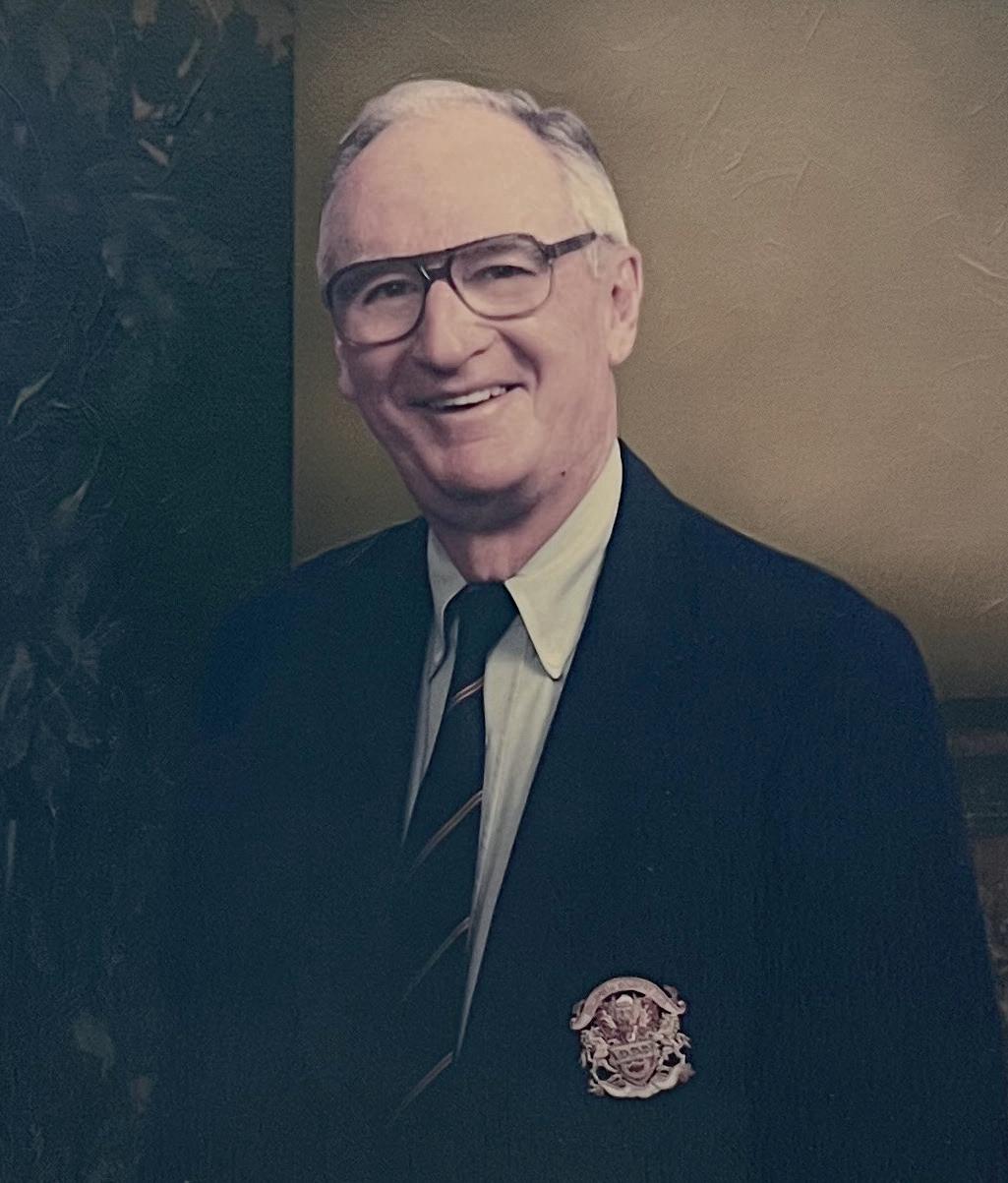
“ coach ” was a world - class teacher and mentor
by james nesbitt
for the past 110 years , columbia country club has been blessed to have had three highly respected head golf professionals : fred mcleod , bill strausbaugh and bob dolan . each of them , through their dedication to the game of golf and their talents , have brought credit to themselves , to their profession and to the club . each in their own way has enriched the membership experience at columbia .
bill strausbaugh , known respectfully and affectionately as “ coach ,” spent a lifetime serving the game of golf . it is no exaggeration to consider “ coach ,” as a washington post writer did after his death in 1999 , as a “ local golf legend .” in truth , that characterization understates the reach of his influence . he was a leader in the professional golfers ’ association and recognized as one of the nation ’ s most respected instructors . among his peers , he was known as the “ pro ’ s pro ” and the “ teacher ’ s teacher .”
thankfully , his presence at columbia and in the pga can be felt to this day . this remembrance attempts to explain how and why .
the early years
William Aloysius Strausbaugh was born on July 22, 1923 in Baltimore, Maryland. He grew up in the Pimlico section of the city, not far from the racetrack that hosts the second leg of horse racing’s triple crown, The Preakness.
He took an interest in golf as a youngster. At the age of 10, Strausbaugh began caddying at Bonnie View Country Club. He took up the game and became a pretty good player in his own right.
Strausbaugh attended Calvert Hall College
High School in Baltimore where, among other extracurricular activities, he served as the Sports Editor of the school’s quarterly literary journal, The Cardinal. He was also a contributor to the journal and thought he might one day pursue a writing career.
In fact, an article he authored his senior year titled “Swing and Sway the Sam Snead Way” gave a clue to his future career path. He supplemented that article with two additional pieces: “The Dream Golfer” and his “AllStar Golf Team.” In his view, the dream
golfer would be a combination of several attributes, including Bobby Jones’ “fluidity and smoothness,” Sam Snead’s downswing, Ben Hogan’s wrist action and Byron Nelson’s temperament. As a high school senior, he had already become an astute judge of the combination of swing mechanics and mental skills needed to excel at the game he loved.
Bill Strausbaugh graduated from Calvert Hall in 1941.
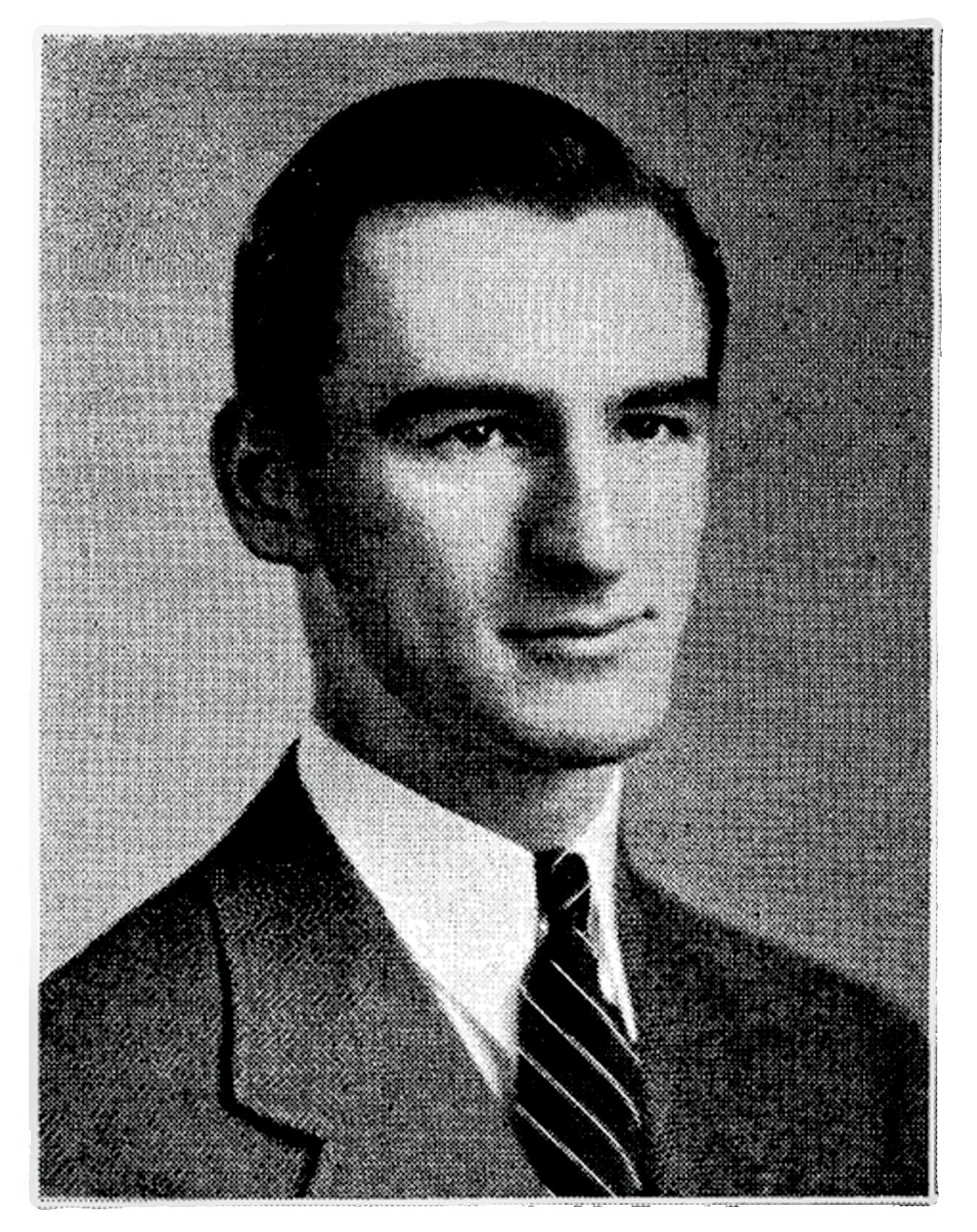
and teaching methods. When asked why he hadn’t become a tour player, Strausbaugh replied: “I was never blessed with natural talent. I made the golf teams in high school and college but was never number one… but I did have the patience to learn technique. Just like I tell my students they must do, I had to ‘learn, earn and acquire’ these skills.”

In the fall, Strausbaugh matriculated at nearby Loyola College. On December 7, 1941, the Japanese attack on Pearl Harbor led to America’s entry into World War II. Within a few months, feeling a call to duty, Strausbaugh interrupted his education and enlisted in the Marines. He served aboard an aircraft carrier, the USS Wasp. The Wasp participated in four major battles in the Pacific Theatre during World War II.
After the war’s end, Strausbaugh picked up where he’d left off at Loyola College and earned his bachelor’s degree in 1946. Since his caddying days, Strausbaugh had become a good golfer, playing well enough to harbor hopes of someday competing on the professional golf tour. The leading professionals at the time were Byron Nelson, Ben Hogan and Sam Snead, all future Hall of Famers.
In the July 1988 issue of Golf Illustrated, Strausbaugh was interviewed about his career
He went on to add that “once I started teaching, that is what I most enjoyed and where any talents I might have seemed strongest.” Strausbaugh opted to become a teacher of the game.
Andy Gibson played an important mentoring role in Strausbaugh’s life. He was a charismatic Scotsman who emigrated from Prestwick. After stints as an assistant professional at two other clubs, Gibson became the head golf professional at the Country Club of Maryland in 1943. Gibson was influential in Strausbaugh’s decision to choose a career path as a club professional. In 1946, shortly after graduating from Loyola, Strausbaugh went to work as Gibson’s assistant. He was there for nine years.
Strausbaugh subsequently served as the head golf professional at two other Maryland clubs. In 1955, he took that position at Fountain Head Country Club in Hagerstown and in 1961 moved on to Turf Valley Golf Club in Ellicott City. He became the head golf professional at Columbia Country Club in 1968.
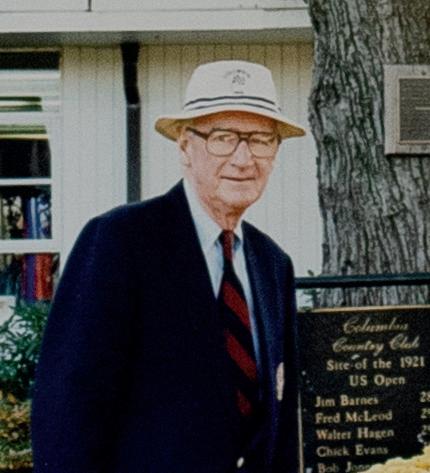
Columbia Country Club, in Chevy Chase, Maryland, had enjoyed the services of Fred McLeod as its head golf professional since 1912 until his retirement in December of 1967—a period of 55 years!
McLeod was a prominent figure in the world of golf. He had won several tournaments that were considered “majors” in his day, including the 1908 U.S. Open at Myopia Hunt Club near Boston, Massachusetts. Between 1907 and 1921, McLeod had eight top ten finishes in our national championship.
In 1921, Columbia Country Club was honored to host the U.S. Open which was won by Jim Barnes. McLeod finished tied for second with the immortal Walter Hagen. In recognition of his many accomplishments, McLeod was elected to the PGA Hall of Fame in 1960.
Filling the shoes of the legendary “Mr. Mac” would be daunting for anyone but Strausbaugh was up to the challenge. Columbia’s members greatly appreciated how respectfully he handled this transition and accommodated McLeod in his emeritus status.
Strausbaugh quickly took charge, bringing skills and qualities to the job that were both unique and outstanding. Foremost, his “people skills” were unsurpassed. His talents as a teacher were highly regarded. He not only understood the technical aspects of the golf swing but also had a gift for knowing how to connect with his students to accelerate their improvement. Strausbaugh had a genius for imparting his love for the game to Club members, other professionals and anyone else who fell into his circle of acquaintance. In so doing, he won the admiration of all.
His talents as a teacher earned him the nickname “The King of Swing” from those in the golf business. At Columbia, he was accorded the honorific title of “Coach.”
It was a measure of respect and endearment for the genuine interest he took in helping Club members improve as players and enhance their enjoyment of the game. His enthusiasm for the game of golf was infectious.
Strausbaugh went to great lengths to offer help that went beyond swing mechanics. Equally important to him was taking an interest in the personal lives of those he came into contact with, often offering them sincere service to columbia country
and thoughtful advice about the game of life.
“Coach” had a wonderful knack for dealing with people from different walks of life. It didn’t matter if you were a golf professional, Club member, guest, employee or caddy. He treated everyone the same and afforded each an equal degree of respect. When you spoke with him, “Coach” always gave you his full attention. He possessed the rare ability that made you feel as if you were the most important person he’d speak with all day. You felt valued as a person.
An illustration of this point occurred many years ago when a new caddy carried a guest’s golf bag to his car. Strausbaugh called the caddy over to him and asked him if he’d been tipped. His interest in the caddy’s welfare left a lifelong impression. The caddy related this story years later, as a middle-aged man, and reflected how touched he had been by Strausbaugh’s concern for him.
Another measure of his interest in others was his uncanny ability to remember the names of people, even those he’d met once and hadn’t seen for years. It’s an important part of his legacy. As this writer often witnessed, Strausbaugh could meet a guest playing in the Club’s annual member-guest tournament and ten years later, without having seen him since, walk up to him on the practice range and greet him by his first name. All of us were astounded by his incredible recall of names.
Another element of Bill Strausbaugh’s distinguished 27 years of service to Columbia is that he began a tradition that has become an important part of the Club’s legacy— extending a “Warm Columbia Welcome” to all visitors, guests, or competitors. This is just one example of the “spirit of Columbia” that seeks to extend genuine hospitality and fellowship to its guests and to the community of which Columbia is a part.
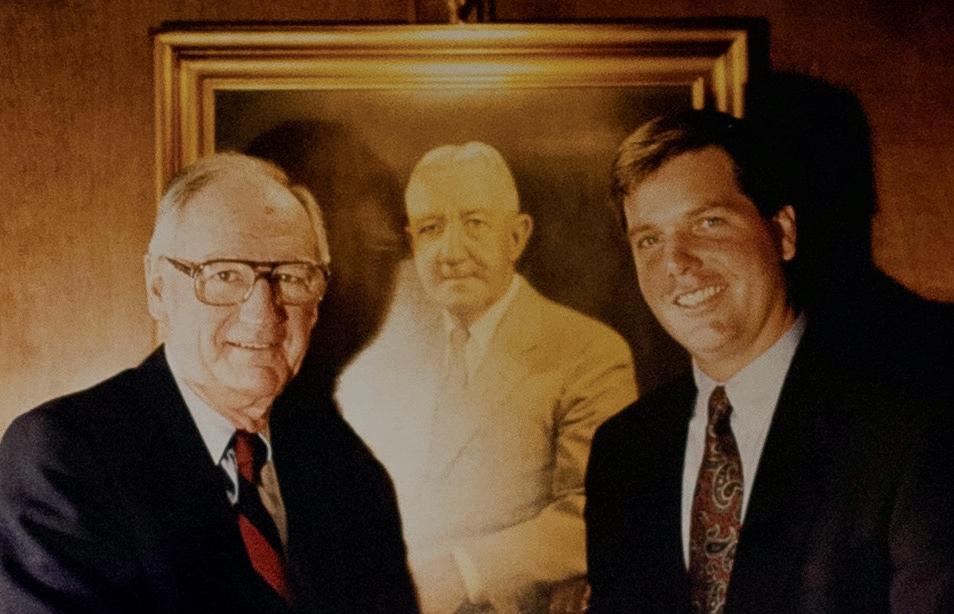
Three generations of Columbia’s Head Golf Professionals.
Bill Strausbaugh and Bob Dolan flank the portrait of Fred McLeod.
a talent for teaching
Strausbaugh’s considerable talents as one of the game’s best teachers were widely recognized. In 1991, Golf Digest honored him by naming him as one of the “50 Greatest Teachers in the Game of Golf.” Over the years, he contributed numerous articles to Golf Digest, Golf magazine and other golf publications.
and could apply that knowledge to the golf lessons he gave to Club members. No one was more committed to being the best teacher he could be.
“ frankly , i feel that the golf swing is totally over - techniqued , overmystified , overtaught and under - coached , and over - undigested . ”
- bill strausbaugh
golf illustrated , july 1988
In 2003, he became the tenth inductee in the World Golf Teachers Hall of Fame, joining other legends such as Tommy Armour, Jim Flick, Davis Love, Jr., Harvey Penick, Paul Runyon and Bob Toski.
His knowledge of swing mechanics and other aspects of the game came from decades of experience. He never stopped learning—he would use every opportunity to expand his understanding of the golf swing.
I recall attending the 1987 Ryder Cup matches at Muirfield Village Golf Club in Dublin, Ohio with “Coach.” As always, the players on both teams were among the best in the world. The three days of intense competition were riveting as the European team eked out a 1513 win over the American squad. Strausbaugh missed much of the on-course action, though, spending most of his time observing the players on the practice range. He explained that he learned more by studying the swing mechanics of the best players in the world
“Coach” used that knowledge to refine his approach and adapt his lessons to golfers with varying levels of ability. His lessons were well thought out. He knew better than to overwhelm a struggling golfer with a long litany of adjustments they needed to make. That approach would only frustrate them.
Instead, he was patient and concentrated on a couple of the most troublesome swing flaws to fix. In his own words, it was more important to use “an instructional teaspoon rather than a shovel.”
Additional bad habits would be left for subsequent lessons. One of his former assistants observed that “Coach’s” lessons were more effective because he prioritized what was achievable. If you were an 18 handicapper, his goal was to get you to a 15. And go from there.
His instruction emphasized the fundamentals. “Coach’s” famous adage has been oft-repeated by his students and other golf professionals: “The golf swing is 98% set-up, 2% is in the take-away, and the rest is in the Lord’s hands!”
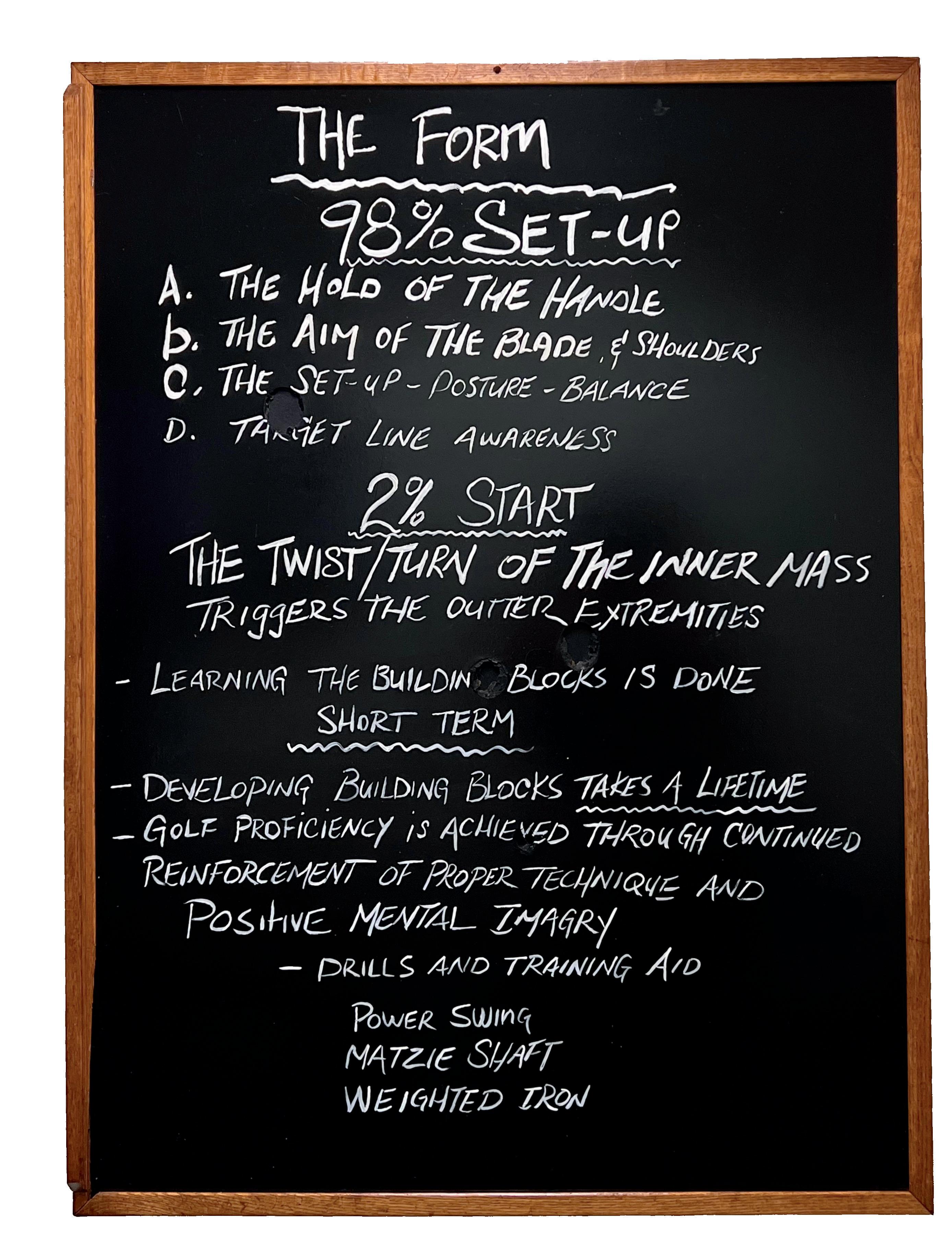
He encouraged his students to focus on the basics. If the fundamentals, particularly the setup, were solid, good results can follow. His job was to cut through the clutter of confusing swing tips and instead help his students focus on a few things over a long period of time— one or more of the five “building blocks” which he taught. In the Golf Illustrated interview, he observed that he was sometimes faulted for being repetitious: “They don’t like to go over too many times the three to five building blocks I give them.” Then, remaining true to his principles, he added “But I tell them up front that I don’t give quick fixes. I may bore them but I’ll never confuse them.”
Another “Coach-ism” would reinforce the point about mastering the fundamentals: “From tiny acorns, giant oak trees grow.”
At the end of each lesson, “Coach” took the time to give the student notes to remind them of the main corrections to focus on. The notes were on a form he developed; it was a “roadmap” of their lesson and a useful tool to guide their practice sessions.
Strausbaugh taught golfers at every level, from touring pros to outright beginners. High
and low handicappers alike benefited from the wisdom he’d impart on the practice tee. Too many members to count credit the “Coach” with improving their play and thus their enjoyment of the game.
One such member is Marty West III, the finest amateur that Columbia has ever produced and a recent inductee into the Maryland Golf Hall of Fame. West attributes advice “Coach” gave him early in his career that improved his swing and helped him resolve problems with an unwelcome hook.
West went on to become one of the best amateur golfers in the country.

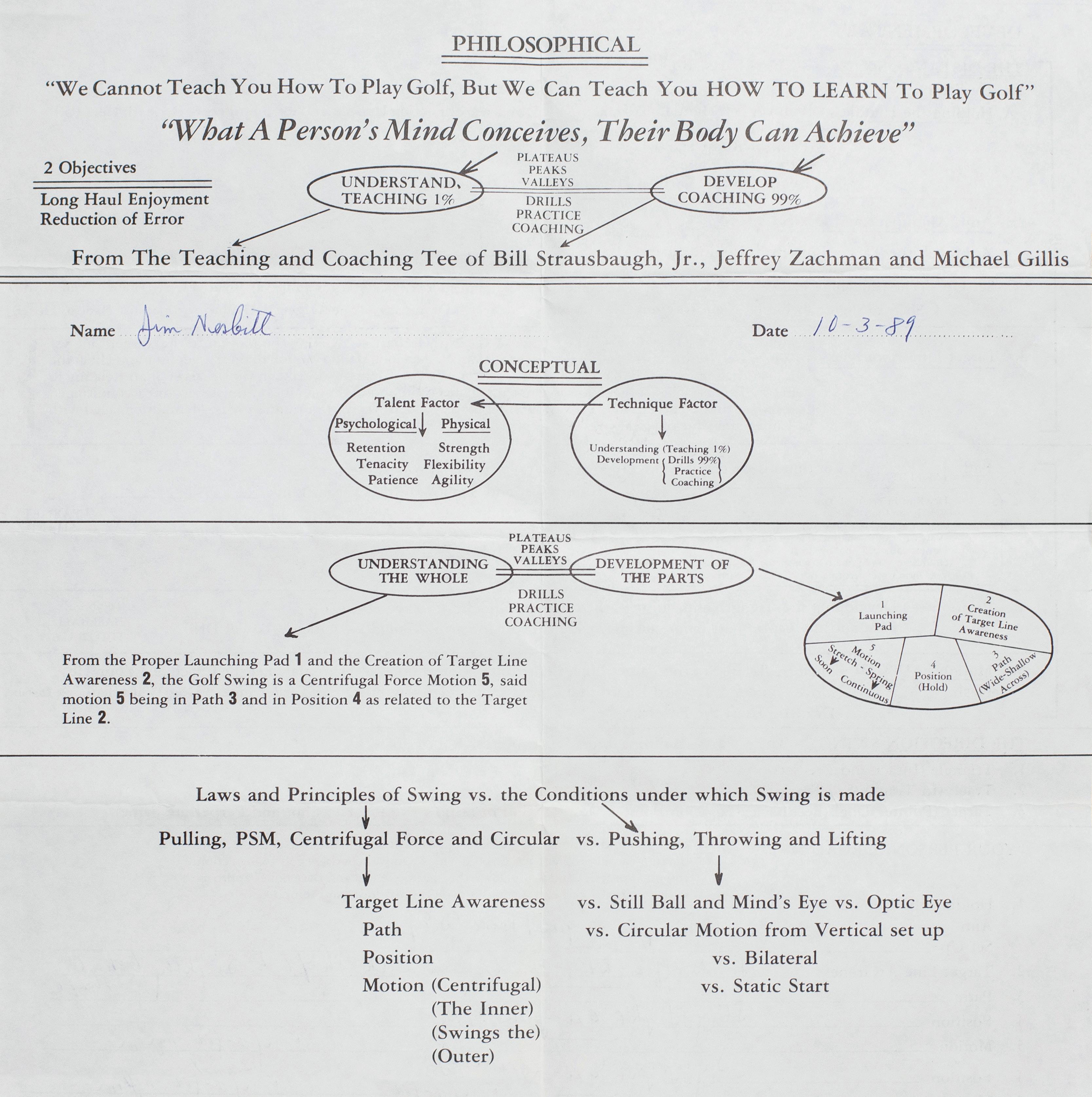
“Coach’s” notes given to the author following a golf lesson.
Among other achievements, West was a twotime All-American at the University of North Carolina and a member of the 1973 and 1979 Walker Cup teams. He qualified for 38 USGA Championships, including nineteen (19) Amateurs, and two U.S. Opens. He also played in four Masters Tournaments.
One PGA Tour professional who sought advice from “Coach” was Tom Kite. On more than one occasion, I saw Mr. Kite working with “Coach” during a lesson on Strausbaugh’s
teaching perch overlooking Columbia’s 18th fairway as I trudged up our home hole myself.
Kite won 19 times on Tour, his most notable championship coming at the 1992 U.S. Open at Pebble Beach Golf Links.
Kite was inducted into the World Golf Hall of Fame in 2004. There’s only one reason why a player of Kite’s ability came to the “Coach” again and again—Strausbaugh was one of the best!
mentoring fellow professionals
“Coach’s” lessons extended well beyond the practice tee. One of his main priorities was to help develop other golf professionals. Recall that his peers regarded him as the “pro’s pro.” That included his successor at Columbia, Bob Dolan, who himself benefitted from Strausbaugh’s sage counsel.
He is warmly remembered by his former assistants, many of whom became head golf professionals at other clubs. They learned from his example the invaluable guidance he provided that helped them advance in the golf business. His handwritten “Roadmap to Success” is something they all cherished (see page 14).
“ taking over as columbia ’ s head golf professional from bill strausbaugh was one of the greatest honors of my life . he continued to offer guidance to others in his emeritus years . he taught me how to become a better golf professional and a better person . ”
- bob dolan
recently after a very distinguished 32-year career as the head golf professional at the Chevy Chase Club. He had also served as the head professional at Sankaty Head Golf Club in Nantucket, Massachusetts. Prior to that, Fitzgerald worked as a Strausbaugh assistant at Columbia for five years in the 1980’s. Fitzgerald has likened Strausbaugh to a father figure: “He was the first person who I tried to be like, to emulate how he interacted with others. I was in awe of him and his sincerity in his treatment of others.”
One such person is Jim Fitzgerald who retired
How Strausbaugh interacted with his
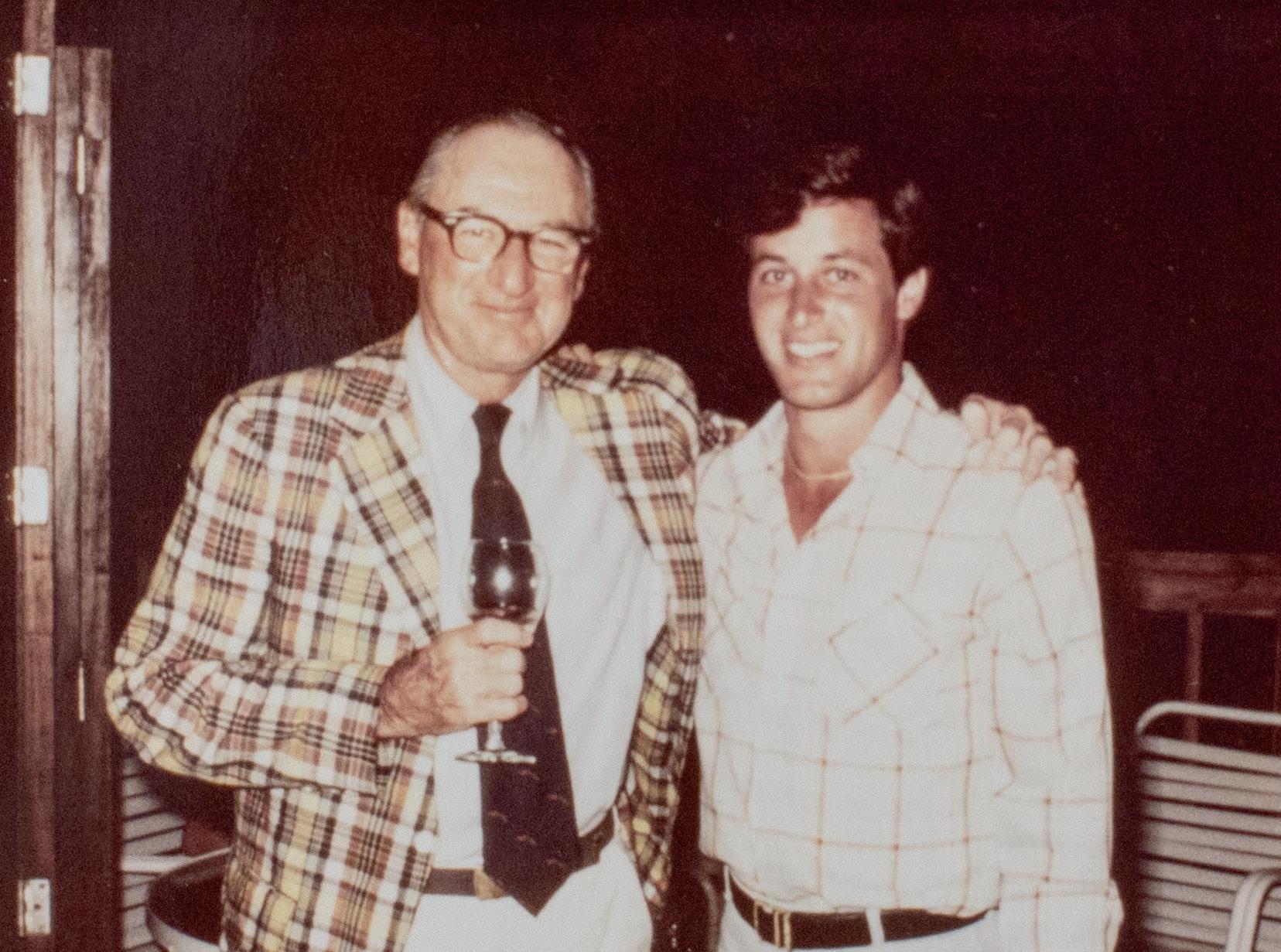
and Jim Fitzgerald.
assistants left a lasting impression. Fitzgerald recalled at the end of his first day on the job at Columbia, “Coach” provided the beer and they sat together in the golf shop office so that he could learn how Jim’s day had gone. It was a sincere indication of personal interest that Fitzgerald hadn’t expected but certainly appreciated.
In similar fashion, soon thereafter, “Coach” gave Fitzgerald an unexpected bonus after he’d sold his first set of golf clubs. Jim was grateful for the financial incentive but it was the thoughtfulness of the gesture that made the biggest impression.
An additional quality that Fitzgerald sought to emulate was the unsurpassed degree of passion and care that “Coach” put into teaching the golf swing. Strausbaugh had a special way of motivating his students to improve just to impress upon him that they understood what he was trying to convey.
In addition to the considerable talents that he brought to his profession in his own
right, Jim Fitzgerald was well served by the lessons he learned from “Coach.” He won many accolades over the years, including the following Middle Atlantic PGA awards: Teacher of the Year (1996), Professional of the Year (2011) and Middle Atlantic Bill Strausbaugh Award (2014). In 2020, Jim Fitzgerald was inducted into the MAGA Hall of Fame. “Coach” would be proud.
Another former assistant, Dennis Satyshur, worked for Strausbaugh during the 1970’s.
After serving as an assistant at several prominent golf clubs, he became the head golf professional at Baltimore Country Club in 1987 and in 1990 was selected as the head professional at Caves Valley Golf Club where he served for more than 30 years. In 1997, Satyshur was appointed Assistant Captain of the U.S. Ryder Cup team by his friend, Captain Tom Kite.
Satyshur recalls that Strausbaugh’s assistants learned so much just by watching him work. He didn’t just tell them what to do, he led by example. In short, “Coach” was their model for what a golf professional should be.
Bill Strausbaugh’s sincerity, warmth and concern for all his assistants extended to their personal as well as their professional lives. His interest in helping them each succeed motivated them all. Satyushur credits what he learned from Strausbaugh as an important factor in his professional success. One such accomplishment that Satyshur takes some degree of pride in: he has 25 former assistants working at clubs as head PGA professionals or directors of instruction.

service to the pga
While Bill Strausbaugh will always occupy a special place in the hearts and minds of the Columbia community, he was also highly respected and admired by the global golfing community. The esteem he won from his peers was earned by his many years of contributions to local, regional, national and international golf organizations.
From 1957 to 1998, “Coach” lectured hundreds of times across the United States and around the world. He appeared at PGA Section meetings and seminars, PGA business schools, PGA teaching and coaching summits as well as at numerous golf associations and colleges and universities. Usually focusing on teaching methods and standards of employment, the “Strausbaugh lecture circuit” traveled to Europe, Canada and Japan.
This author became aware of his international acclaim at the aforementioned 1987 Ryder Cup. There I met a German golf professional who asked where I was from. When I told him that my home course was in Maryland, his first question was whether I knew Bill Strausbaugh. He told me he knew Bill well and that Bill had conducted coaching clinics in many parts of Europe that had been very well received by the professionals there.
Closer to home, “Coach” was deeply involved in the Middle Atlantic PGA for many years and served as its president from 1974 to 1977.
He was inducted into the MAPGA’s Hall of Fame in 1989.
Strausbaugh also served the PGA of America first as the chairman of its club relations and employment committee and later as a national vice president in 1975. His insights and advice on employment matters was highly valued. His peers sought his counsel on various matters, such as how to improve membership service, how to better deal with club Board issues and how to enhance income opportunities.
His people skills were also appreciated. “Coach” could be relied on to calm hotly contested PGA sectional meetings and bridge differing viewpoints. He was very effective at helping his peers come together to resolve difficult issues they were working on.
“ he won the pga ’ s professional of the year honor in 1966 , the horton smith trophy for outstanding contributions to professional education in 1983 ( renamed in 2020 as the pga professional development award ) and teacher of the year honors in 1992 . bill strausbaugh is the only pga professional to have been awarded all three . ”
Bill Strausbaugh won many awards throughout his golf career. Nationally, he won the PGA’s Professional of the Year honor in 1966, the Horton Smith Trophy for outstanding contributions to professional education in 1983 (renamed in 2020 as the PGA Professional Development Award) and Teacher of the Year honors in 1992. Bill
Strausbaugh is the only PGA professional to have been awarded all three.
In addition, the National Golf Foundation recognized his achievements as a teacher par excellence with the Joe Graffis Award for outstanding dedication to the advancement of golf education in 1977.
the pga ’ s bill strausbaugh award
Perhaps the crowning honor for a man so decorated with awards for his contributions to the game of golf was the creation of the Bill Strausbaugh Award by the Professional Golfers’ Association of America in 1979. The PGA presents this award annually to a PGA Professional who by their day-to-day efforts have distinguished themselves by mentoring their fellow PGA Professionals in improving their employment situations and through service to the community.
At the time of Bill Strausbaugh’s death in 1999, Will Mann, then the president of the PGA, celebrated his life and his contributions to the game:
“Bill Strausbaugh’s career was a study in dedication to people as well as a love of the game itself. He worked diligently to improve the welfare of PGA Professionals and became an inspiration to everyone with whom he came in contact.”

“Receiving the National Strausbaugh award was a tremendous honor for me, particularly because it was named for Bill Strausbaugh.”
- Bob Dolan, 2011 Award Recipient




